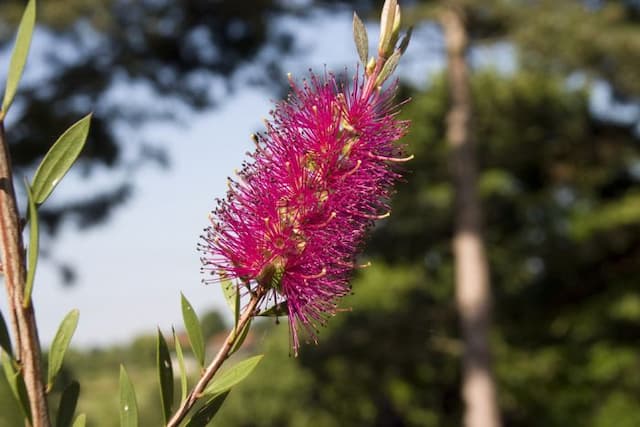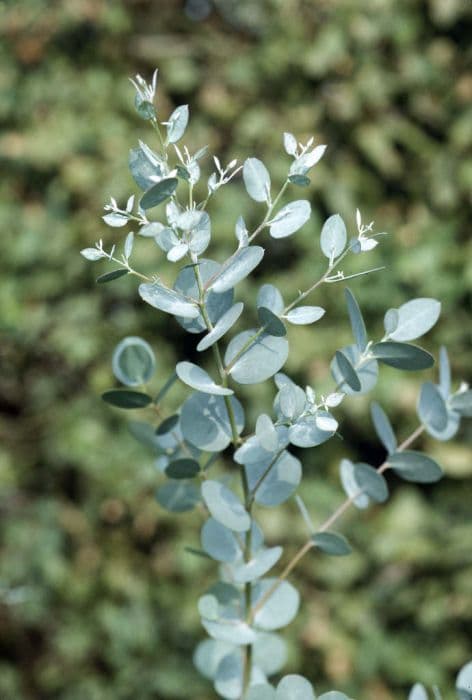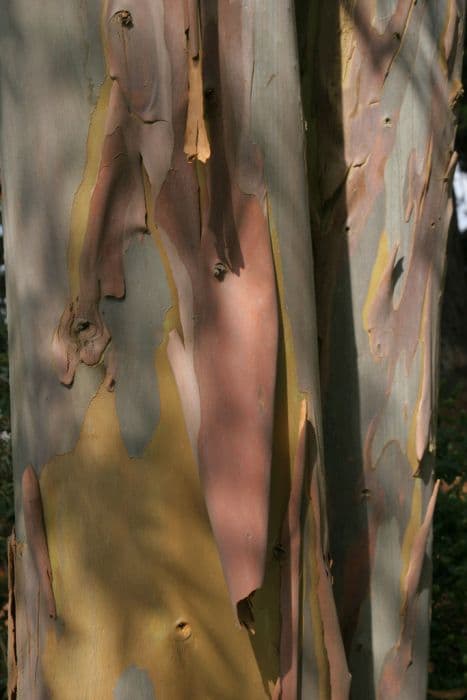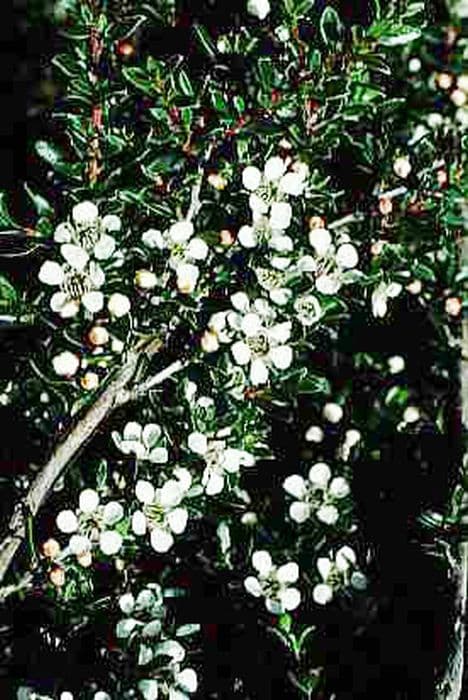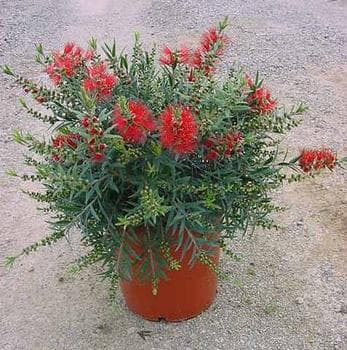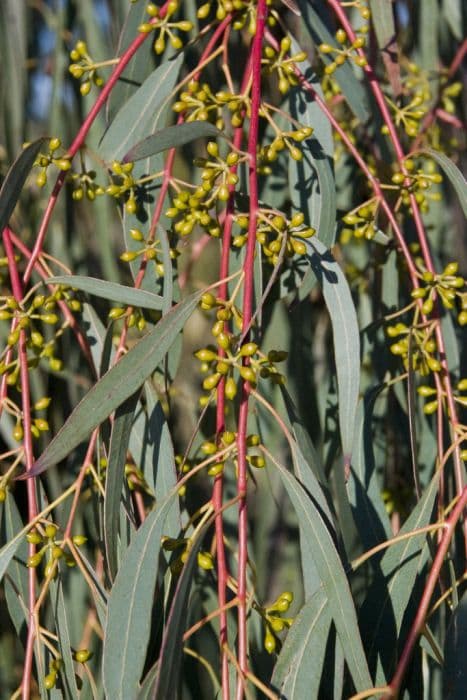New Zealand Tea Tree Leptospermum scoparium (Nanum Group) 'Kiwi'

ABOUT
The 'Kiwi' is a striking plant that is part of the Manuka group, known for its small, dense, needle-like foliage which presents a rich dark green color. Throughout the year, this dense foliage creates an attractive, bushy appearance, but it is during the flowering season when the 'Kiwi' truly shines. At this time, it becomes adorned with a profusion of double flowers that exhibit a vibrant, deep pink hue with a slightly ruffled look. These blossoms are not only a feast for the eyes; they also attract a variety of pollinators, adding a lively buzz to its surrounding. The rich, evergreen leaves continue to provide visual interest even when the plant is not in bloom, maintaining a lush appearance year-round. The overall impression of the 'Kiwi' is one of a compact, colorful, and inviting plant that contributes a touch of elegance and natural charm to any garden setting.
About this plant
 Names
NamesFamily
Myrtaceae.
Synonyms
New Zealand Tea Tree, Manuka, Kiwi.
Common names
Leptospermum scoparium 'Kiwi', Leptospermum scoparium var. nanum 'Kiwi', Leptospermum nanum 'Kiwi'.
 Toxicity
ToxicityTo humans
The Manuka, commonly known as Leptospermum scoparium, including the 'Kiwi' variety, is not known to be toxic to humans. There are no well-documented cases of Manuka causing poisoning symptoms in people. However, as with any plant, individual allergies or sensitivities can occur, and it is always advisable not to ingest any part of ornamental plants as a precaution.
To pets
The Manuka, commonly known as Leptospermum scoparium, including the 'Kiwi' variety, is also not known for being toxic to pets such as dogs and cats. There is no widespread evidence to suggest that this plant poses a significant risk if ingested by pets. Nevertheless, the general principle of preventing pets from eating ornamental plants is wise, as individual animals might have sensitivities or allergic reactions, and ingestion of non-food items can lead to gastrointestinal discomfort or blockages.
 Characteristics
CharacteristicsLife cycle
Perennials
Foliage type
Evergreen
Color of leaves
Green
Flower color
Pink
Height
3 feet (0.91 meters)
Spread
3 feet (0.91 meters)
Plant type
Shrub
Hardiness zones
8
Native area
New Zealand
Benefits
 General Benefits
General Benefits- Aesthetic Appeal: Manuka 'Kiwi' is appreciated for its beautiful, vibrant flowers that add color and visual interest to gardens and landscapes.
- Attracts Pollinators: This plant is a natural magnet for bees and other pollinators, which are essential for a healthy ecosystem.
- Low Maintenance: Manuka 'Kiwi' is known for being hardy and requiring minimal care once established, making it an ideal choice for gardeners of all skill levels.
- Evergreen Foliage: As an evergreen shrub, it provides year-round greenery, which can be especially valuable in winter months when other plants may be dormant.
- Drought Tolerance: Manuka 'Kiwi' has a good tolerance to drought conditions once established, making it suitable for xeriscaping and regions with water restrictions.
- Soil Adaptability: It can adapt to a range of soil conditions, although it prefers well-drained soils.
- Compact Growth: The Nanum Group varieties, such as 'Kiwi', have a compact growth habit, making them suitable for small gardens and containers.
- Wind Resistance: This plant can withstand windy conditions, making it a good choice for coastal areas or exposed landscapes.
- Wildlife Habitat: The dense foliage provides shelter for birds and small mammals.
 Medical Properties
Medical Properties- Antibacterial: Leptospermum scoparium, commonly known as Manuka, has been found to possess antibacterial properties, particularly due to the compound methylglyoxal (MGO) present in Manuka honey produced from its nectar.
- Antiviral: Studies suggest that Manuka honey might have antiviral effects.
- Anti-inflammatory: Manuka honey and extracts from the Manuka plant may exhibit anti-inflammatory properties which can aid in reducing inflammation.
- Antioxidant: Manuka honey contains antioxidants that can neutralize free radicals and reduce oxidative stress in the body.
- Wound healing: Manuka honey is used topically to promote healing in wounds, ulcers, and burns due to its antibacterial and anti-inflammatory properties.
 Air-purifying Qualities
Air-purifying QualitiesThis plant is not specifically known for air purifying qualities.
 Other Uses
Other Uses- Leptospermum scoparium 'Kiwi' is often used in floral arrangements for its attractive, small dark foliage and tiny, colorful flowers that complement other blooms.
- The wood from Manuka is dense and can be used for crafting small, durable items such as decorative inlays and jewelry.
- Manuka sawdust and chips are sometimes used in smoking meats and cheeses to impart a distinct, rich flavor.
- The essential oils extracted from this plant can be used in aromatherapy diffusers for a subtle, pleasant fragrance in the home.
- The flowers of Manuka can serve as natural dyes, providing shades of yellow and green when used in traditional fabric dyeing practices.
- Beekeepers sometimes place beehives near dense plantings of Manuka to encourage the production of Manuka honey, although not directly using the plant, its influence is significant in the quality of the honey.
- Cultivating Manuka plants can be considered as a conservation effort to provide habitat and food for endangered native butterfly and moth species.
- Used as a natural edge or border within landscapes, Manuka can help delineate spaces organically without the need for man-made fencing materials.
- The thick foliage and bushy habit of Manuka make it an excellent choice for creating privacy screens in gardens and urban settings.
- When dried, the branches and wood of Manuka are sometimes employed in crafting traditional musical instruments or for ceremonial objects in some indigenous cultures.
Interesting Facts
 Feng Shui
Feng ShuiThe Manuka is not used in Feng Shui practice.
 Zodiac Sign Compitability
Zodiac Sign CompitabilityThe Manuka is not used in astrology practice.
 Plant Symbolism
Plant Symbolism- Healing: 'Kiwi' belongs to the Leptospermum genus, commonly known as Manuka. Manuka is widely recognized for its medicinal properties, especially the healing benefits of its honey, suggesting the symbolic meaning of healing and rejuvenation.
- Resilience: Manuka plants are known for their toughness and ability to survive in challenging and rugged environments, symbolizing resilience and the ability to endure hardships.
- Protection: The Manuka has often been used in the past for its protective properties, with its wood being durable and its essences used to repel insects, symbolizing protection against harm.
- Purity: Manuka honey is often associated with purity due to its antibacterial properties, making the plant symbolize purity and cleanliness.
- Rarity: 'Kiwi', as a cultivated variety of Manuka, can be considered rare and unique, symbolizing the value of rarity and distinctiveness.
 Water
WaterThe New Zealand Tea Tree should be watered thoroughly, ensuring that the soil is evenly moist but not waterlogged. It's best to water the plant when the top inch of soil feels dry to the touch, which might be around once a week, depending on environmental conditions. During the growing season in spring and summer, you may need to water more frequently, especially if outdoor conditions are warm. However, in the winter, you should reduce watering to when the soil is dry a few inches down. Each watering session might require about a gallon of water for an established plant, depending on its size and the pot's volume.
 Light
LightNew Zealand Tea Tree thrives in full sun conditions with at least six hours of direct sunlight per day. It prefers a location that offers bright and unfiltered sunlight, so placing it in a south-facing spot would be ideal. However, in extremely hot climates, some light afternoon shade can be beneficial to prevent scorching of the leaves.
 Temperature
TemperatureNew Zealand Tea Tree does well in a temperature range of 50 to 70 degrees Fahrenheit, but it can tolerate a little cooler or warmer as well. This plant can withstand temperatures down to about 20 degrees Fahrenheit for short periods but should be protected from frost to prevent damage. Ideal growing conditions would maintain a steady temperature without extreme fluctuations.
 Pruning
PruningPrune the New Zealand Tea Tree to maintain shape and promote bushier growth, doing so after the flowering season has ended. Light pruning can be done annually, but a more thorough shaping should be limited to every few years to avoid stressing the plant. The best time for major pruning is in late winter or early spring before new growth begins.
 Cleaning
CleaningAs needed
 Soil
SoilThe New Zealand Tea Tree ('Kiwi') prefers well-draining, acidic to neutral soil (pH 5.0-7.0). A mix of peat, perlite, and potting soil in equal parts works well.
 Repotting
RepottingNew Zealand Tea Tree ('Kiwi') typically requires repotting every 2-3 years, or when it's clearly outgrowing its current pot.
 Humidity & Misting
Humidity & MistingNew Zealand Tea Tree ('Kiwi') is adaptable but prefers moderate to high humidity levels for optimal growth.
 Suitable locations
Suitable locationsIndoor
Use bright, indirect light and well-draining soil for indoor New Zealand Tea Trees.
Outdoor
Plant in full sun to partial shade in well-draining soil for outdoor growth.
Hardiness zone
New Zealand Tea Tree ('Kiwi') is suitable for 9-11 USDA zones.
 Life cycle
Life cycleThe life cycle of Leptospermum scoparium 'Kiwi', commonly known as Manuka or New Zealand Tea Tree, begins with seed germination, which requires well-draining soil and warm temperature conditions to trigger growth. Following germination, the seedling stage involves the development of roots and shoots that emerge from the seed, and the establishment of the first leaves that can photosynthesize. As it enters the vegetative growth phase, the plant develops a robust woody stem and dense foliage, experiencing substantial growth in size and form. When mature enough, the Manuka enters the reproductive stage, typically marked by a profusion of attractive small white or pink flowers, which attract pollinators like bees and insects, resulting in pollination. After successful pollination, the flowers give way to seed capsules that eventually release seeds, allowing the plant to propagate. Lastly, the plant gradually reaches senescence, where growth slows down, and it may become more susceptible to diseases and pests, eventually completing its life cycle with the death of the plant.
 Propogation
PropogationPropogation time
Spring-Early Summer
The Manuka or New Zealand Tea Tree, scientifically known as Leptospermum scoparium (Nanum Group) 'Kiwi', is commonly propagated using semi-hardwood cuttings. This method typically takes place in late summer when the current season's growth has begun to harden. Cuttings about 4 to 6 inches (10 to 15 centimeters) long are taken from healthy parent plants. The lower leaves are removed, and the base of the cutting is dipped in a rooting hormone to enhance root development. The treated cuttings are then placed in a well-draining potting mix. The cutting environment should be kept humid, which is often achieved by covering the pot with a plastic bag or placing it in a propagator. It is essential to maintain constant moisture and provide indirect light until the cuttings have rooted, which can take several weeks. After successful root development, the new plants can be transplanted into individual pots to continue growing.
